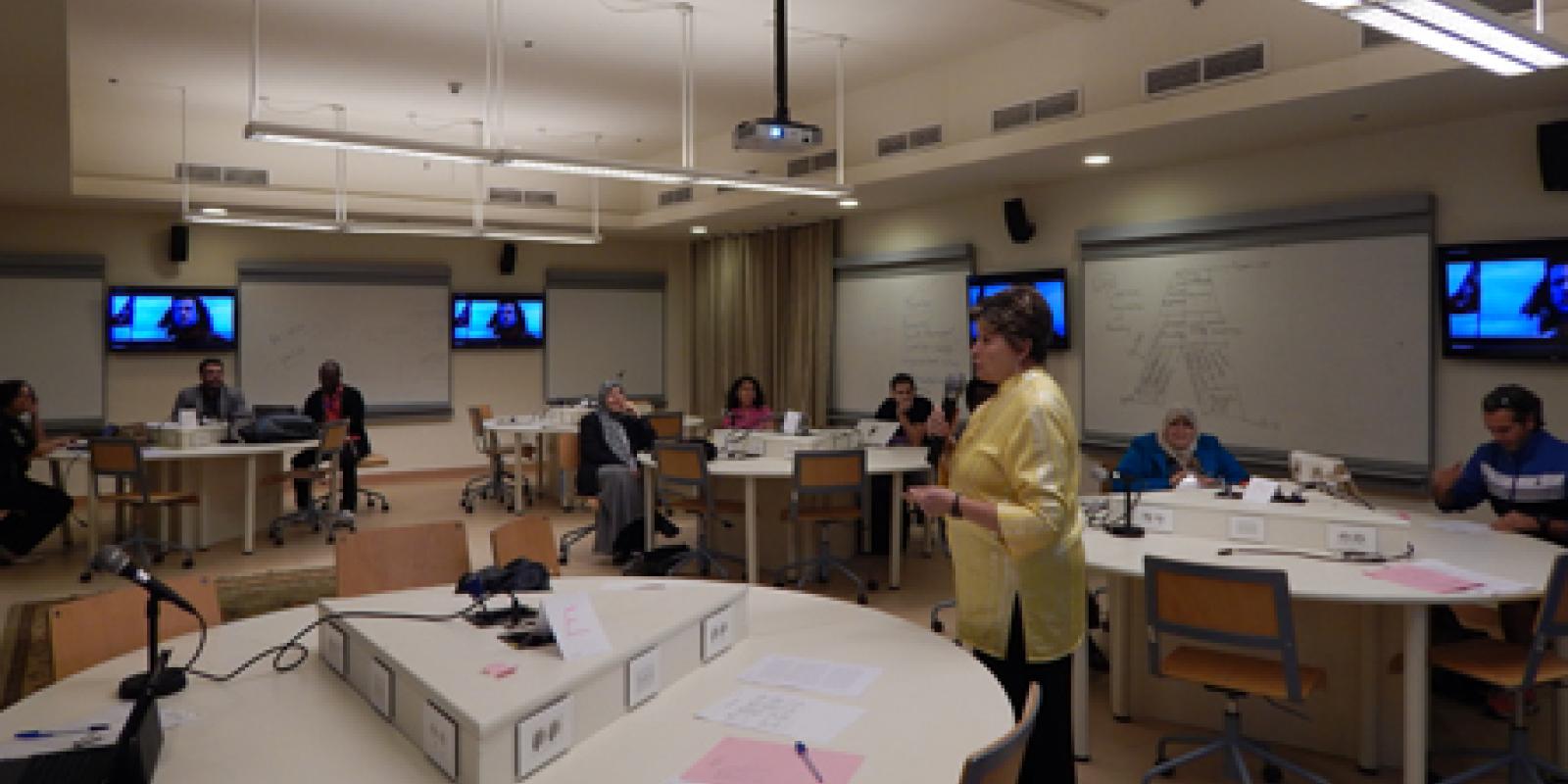
Redesigned Classroom Promotes Interactivity, Self-Directed Learning
In an effort to promote new pedagogical approaches that encourage student collaboration and active learning, the Graduate School of Education (GSE) recently opened an interactive classroom, the first-of-its-kind in Egypt.
Modeled after 27 classrooms at the University of Minnesota, the GSE interactive classroom includes multiple flat-panel display projection screens (LCDs), as well as round tables that seat several students each to encourage collaboration and peer teaching. With their laptops and tablets connected to each table, students may upload their group work to show on the screen at their table or on all screens at once, allowing them to present their projects for review by their classmates and instructors.
“With this model, the teacher is not center-stage,” explained Gihan Osman, assistant professor at the GSE. “The students are not seated in rows or a U-shaped seminar setting facing the teacher, thereby discouraging the traditional paradigm of education as knowledge transmission from the expert teacher to the recipient students. The learning space and interactive technology open teachers’ minds to new ways of doing things. Most teachers would not feel comfortable lecturing in an interactive classroom.”
Research has shown that changing the design of classroom space from one-way, presentational tutoring to a two-way, or even multi-way, interactive setting affects students’ performance and motivation to learn. “When students project their work on the screens, they become more engaged because everybody is looking and evaluating,” Osman noted. “It increases their accountability, self-esteem and gives them a voice.”
In the past five years, educators have turned to the redesign of learning spaces to be able to engage students and support collaborative and interactive learning. Empirical research conducted at the University of Minnesota has shown that the performance of students who are immersed in a technologically rich environment, with interactive learning methods, is better than students who take the same course in a traditional classroom setting. “Classroom technology is no longer limited to computer labs or projector screens,” said Ted Purinton, associate provost for strategic initiatives, associate professor and associate dean of the GSE. “Students now connect their wireless tablets, mobile devices, digital cameras and other equipment in the classroom. Yet the technology is not the main point; what is more important is how instructors use that technology to achieve the purpose of more engaged and self-directed learning.”
The GSE interactive classroom is a pilot project that would help faculty members understand how the concept of student-centered teaching fits into the local Egyptian context and that of AUC. “Cultural context is critical,” noted Purinton. “The way people perceive their learning is different across cultures. So despite current research in the United States, for instance, we need to better understand how to use these resources for learners in Egypt, both at the university level, as well as the school level.”
The challenge, added Purinton, is for all parties to accept the role of the teacher as a facilitator, not the ultimate source of knowledge. “In the 21st century,” he explained, “the role of educators should be to create opportunities for students to explore and discover new things, and take ownership of their learning experience. The teacher guides students to become independent learners and acquire information inductively. As teachers, we should not just focus on content, but empower students to acquire skills such as collaborative knowledge building and creative problem solving. While this technology cannot automatically facilitate this skill acquisition, it can provide instructors with new tools to interactively lead students as they carry out certain activities or debate issues.”
The interactive classroom is one of two that are due to open at the GSE. Besides classes, the room will also serve as a laboratory for AUC faculty members who wish to explore how technology in various forms may encourage student-centered teaching and learning in various disciplines. “By examining and reflecting on our experiences, we will be able to understand faculty and student perceptions, as well as what works and what doesn’t, with regard to the interactive classroom,” Osman said. “This will help us define our way forward in terms of learning-space design, pedagogy and technology.”
Photo caption: Stacie Rissmann-Joyce, director of the Principals Academy at the GSE, uses the interactive classroom to engage students who are taking a course on leadership
